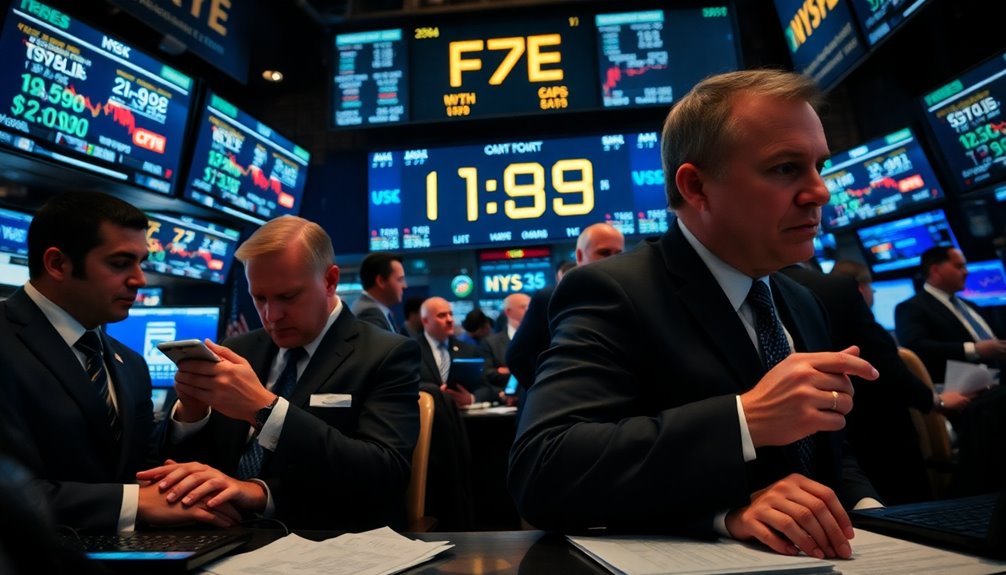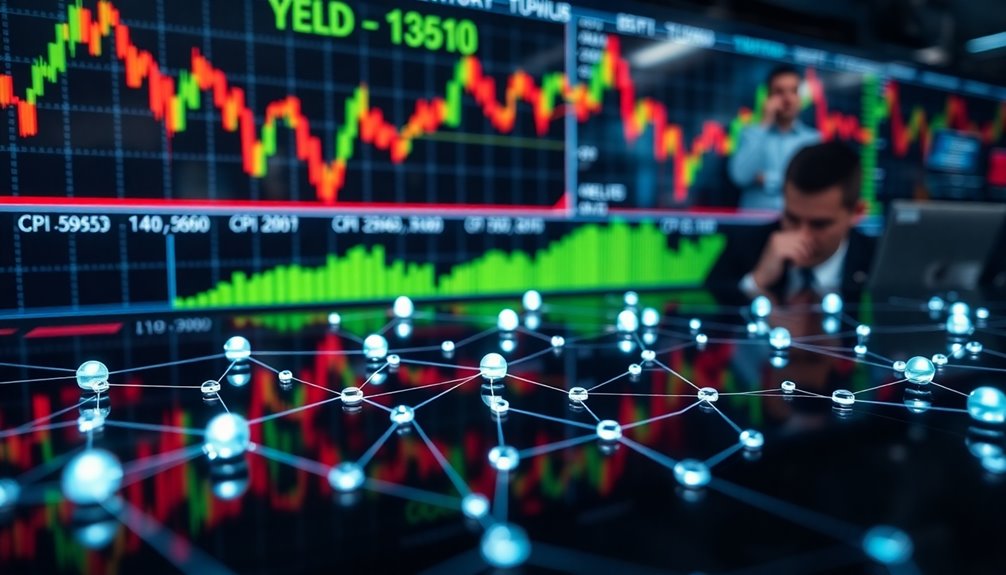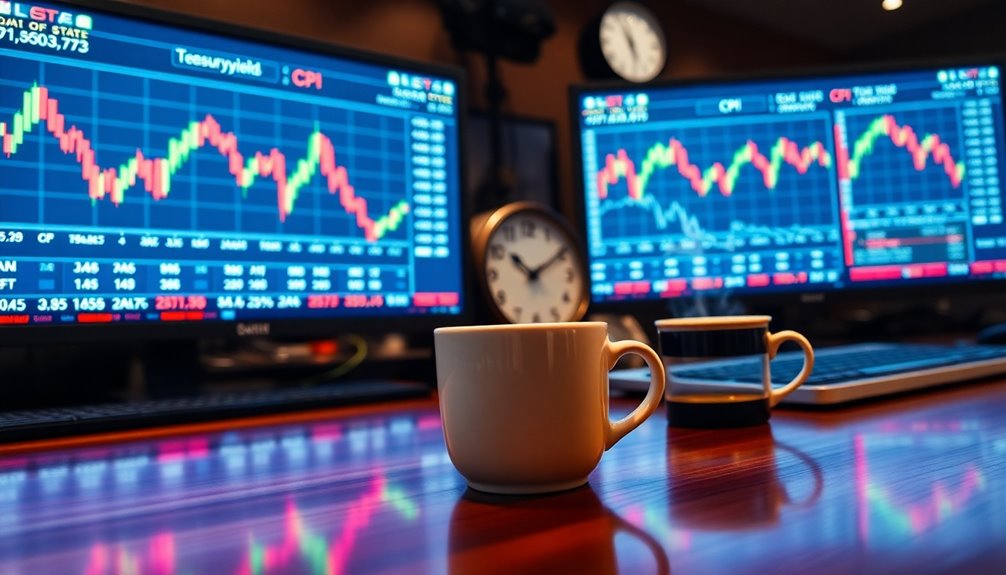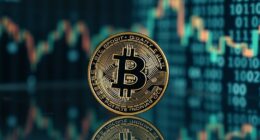Rising Treasury yields and mixed CPI data are fueling market jitters as you gear up for the Fed's next decision. With Treasury yields hovering around 4.5% and inflation expectations lingering, uncertainty is palpable. Consumer sentiment dropped to 73.2, reflecting worries about economic stability. The S&P 500 and Nasdaq 100 both fell, highlighting fading hopes for rate cuts. Job growth remains positive, but the overall economic picture is clouded. As the Fed closely monitors employment and inflation, expect more shifts. If you want to uncover deeper insights about the market landscape, there's more to explore.
Key Takeaways
- Rising Treasury yields near 4.5% signal market concerns about inflation and economic growth, impacting investor sentiment.
- Mixed economic indicators, including a drop in consumer sentiment to 73.2, add to market unease before the Fed's decision.
- Job openings surged to 8.1 million, while payroll growth of 256,000 suggests a tight labor market influencing Fed policy.
- Headline inflation is projected at 2.8%, with core inflation stable at 3.3%, complicating the Fed's interest rate strategy.
- Market expectations indicate two anticipated rate cuts in 2025, contingent on inflation and employment data assessments by the Fed.
Market Volatility Sparks Concern

As the market grapples with rising Treasury yields and mixed economic indicators, volatility is causing unease among investors. You might notice strong employment figures with job openings surging to 8.1 million and payroll growth of 256,000, but consumer sentiment has dipped to 73.2. Inflationary pressures are rising, with headline inflation expected to reach 2.8% year-on-year and core inflation steady at 3.3%. These factors have pushed Treasury yields higher, leading to a 2.1% drop in the S&P 500 and a 2.3% loss in the Nasdaq 100. With expectations for Federal Reserve rate cuts fading, you can see why market participants are on edge, weighing both economic strength and rising inflation as they anticipate the Fed's next move. Additionally, increased market efficiency is anticipated as agents react to new information, which could further influence investor behavior.
Regulatory Changes Impacting Markets

Regulatory changes are set to reshape markets significantly, especially as new frameworks like the Basel reforms and the EU's Digital Operational Resilience Act (DORA) come into play.
Starting January 1, 2025, the Basel reforms will enforce stricter capital requirements, emphasizing financial stability, liquidity monitoring, and stress testing. This aligns with the overall goal of enhancing financial stability in the banking sector, as effective keyword optimization strategies can help firms understand and adapt to these new regulations.
Meanwhile, DORA will take effect on January 17, 2025, impacting EU-based financial entities and imposing operational resilience standards. By March 2025, firms must demonstrate they can withstand severe stress scenarios.
Additionally, the UK's APP fraud rules are now active, pushing for effective implementation to enhance consumer protections.
These changes will require you to adapt strategies, ensuring compliance while navigating the evolving regulatory landscape.
Consumer Spending Patterns

With consumer confidence on the rise, spending patterns in 2025 are poised to change significantly. You can expect a 5.5% global increase in consumer spending, adding $3.2 trillion compared to 2024. Essential goods like housing and food will lead this growth, while discretionary spending, especially on travel and dining, signals a willingness to indulge. Notably, this projected increase in spending aligns with rising consumer confidence as households adapt their budgets amidst economic recovery.
You'll likely seek value, opting for bulk purchases and discounts without sacrificing quality. Intentional spending habits will emerge, where you'll leverage your funds strategically while staying mindful of economic fluctuations. Despite tight budgets, many will prioritize health and wellness and express a strong desire to travel.
Blockchain Integration in Finance

Blockchain integration in finance is revolutionizing the way you handle transactions and manage investments. By reducing infrastructure costs significantly, it can save the financial sector billions annually. Smart contracts eliminate intermediaries, cutting down costs and speeding up processes. You'll find that blockchain automates tasks, enhancing efficiency and lowering labor costs. Its transparent nature minimizes errors and improves data security, thanks to its decentralized architecture. Furthermore, the shift towards decentralized finance (DeFi) enhances access to a wider range of financial services. With faster cross-border payments and decentralized lending, accessing financial services becomes easier than ever. Plus, you can explore new investment opportunities in cryptocurrencies and decentralized finance (DeFi) applications.
Election Year Policy Shifts

As election years approach, you might notice shifts in Federal Reserve policy that reflect both economic conditions and political pressures.
Historically, the Fed has adjusted rates in every election year except 2012, with average changes of 135 bps up and 140 bps down. You'll find the Fed often cuts rates as elections near, showing reluctance to change policy within two months of voting. Significant actions have occurred, such as five rate cuts and five rate hikes recorded in election years since 1980.
Incumbent presidents typically prefer a strong economy, influencing these decisions. Past examples, like the significant cuts in 2008 and 1992, highlight this trend.
Moreover, political pressure can prompt policy changes, as seen with President Nixon in 1972. Understanding these dynamics can give you insight into potential market reactions during election cycles.
Interest Rate Projections Ahead

While the Fed's current policy stance reflects cautious optimism, interest rate projections indicate a complex landscape ahead.
You'll notice that the Fed anticipates two rate cuts of 25 basis points in 2025, totaling 50 bps, while the current federal funds rate sits between 4.75% and 5.00%.
Market expectations suggest stabilization in the 3.75%-4% range, yet some investors foresee a slower cut pace.
Elevated ten-year Treasury yields, near 4.5%, stem from strong economic growth and inflation concerns, influencing demand for U.S. Treasuries. The Fed's current federal funds rate is adjusted to a 4.25% – 4.50% range, which will guide their decision-making moving forward.
The Fed's focus on inflation and employment data will guide future policy adjustments, but the divergent views among policymakers add uncertainty to these projections, making the path ahead even more intricate.
Frequently Asked Questions
How Do Treasury Yields Affect Individual Investors' Portfolios?
Treasury yields significantly affect your portfolio by influencing bond prices and overall investment strategies.
When yields rise, bond prices drop, pushing you to consider higher-risk assets. You might reassess your risk tolerance and shift allocations, especially if you're concerned about inflation.
Diversifying across asset classes or investing in shorter-term bonds can help mitigate potential losses.
Regularly rebalancing your portfolio ensures you maintain your desired risk profile amid changing market conditions.
What Is the Relationship Between CPI Data and Inflation Expectations?
As the saying goes, "a stitch in time saves nine." Understanding the relationship between CPI data and inflation expectations helps you anticipate economic changes.
When CPI rises, it often signals higher inflation expectations, reflecting consumers' worries about future costs. Lower-income households tend to expect higher inflation due to their sensitivity to price increases on necessities.
These expectations, in turn, can influence spending behavior and overall economic stability, impacting your financial decisions.
How Often Does the Federal Reserve Meet to Discuss Interest Rates?
The Federal Reserve meets eight times a year to discuss interest rates. Each meeting lasts two days, and they typically occur every six to eight weeks.
On the second day, you'll hear their policy decision at 2 pm Eastern time, followed by a press conference with the Fed chair at 2:30 pm.
These meetings allow the FOMC to evaluate economic conditions and adjust monetary policy as needed.
What Are the Implications of a Rising CPI for Everyday Consumers?
A rising CPI impacts you by increasing the cost of everyday essentials like food and shelter.
You might find your purchasing power shrinking, forcing you to adjust your budget and prioritize necessary items over luxuries.
You could start seeking sales or opting for cheaper brands to cope with higher prices.
This inflation affects you more if you're on a fixed income, making it crucial to adapt your shopping habits and manage your finances wisely.
How Can Geopolitical Events Influence Treasury Yields and Market Stability?
Did you know that during times of geopolitical tension, demand for U. S. Treasuries can spike, causing yields to drop significantly? This flight to safety often occurs as investors seek stability in uncertain environments, prompting them to move away from riskier assets. As a result, the bond market reacts, reflecting this increased demand and subsequently lower yields. Understanding these dynamics can provide valuable insights, especially when considering usdt market trends and analysis, which can further illustrate how investors are navigating periods of volatility in the global financial landscape.
When uncertainty looms, you might notice investors flocking to safer assets, leading to market volatility.
As geopolitical events unfold, they can drive inflation expectations up, prompting central banks to adjust monetary policies.
This dynamic interplay can create a ripple effect, impacting overall market stability and influencing your investment choices directly.
Conclusion
As you navigate the current market landscape, it's clear that the interplay of treasury yields and CPI data is keeping investors on their toes. With regulatory changes and evolving consumer spending patterns, you're witnessing a real tightrope act. As the Fed prepares for its next move, staying informed and adaptable will be key. Remember, in times like these, it's not just about weathering the storm but learning to dance in the rain. Your strategy will define your success.









